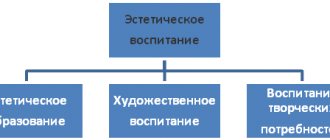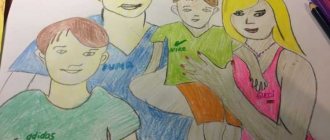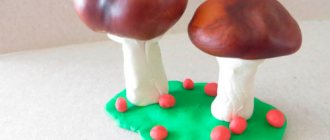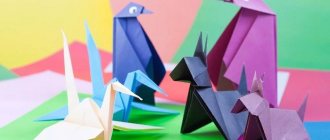Small children experience the world by touch. Application helps to embody the images and objects seen on paper or using other materials. For small children, paper dishes using the appliqué technique will be a good opportunity to learn the names of objects. And adult children hone their skills of believability in crafts.
It can be made from paper, fabric and plasticine. Tableware applique is most often simple and almost all of its types are suitable for preschoolers and kindergarteners. And having supplemented the basic craft with his own elements, the child will take the craft to school.
Glasses in applique
Offer to make your child a refreshing glass of lemonade. Cut out the glass. The lemon circles will be made from circles and triangles of colored paper. Ice cubes are made from soaked thin napkins. Add a straw and the craft is ready.
You can make a summer cocktail using a colored paper coffee cup. Cut it in half lengthwise and stick it on cardboard. Garnish with a citrus slice (umbrella). Decorate the background as desired.
Children's applique – Teapot and teaware
I suggest you consider a composite applique made of cardboard and colored paper “Teapot”.
For kids, you need to cut out all the necessary details in advance, and children 5-6 years old will be able to do it themselves, using downloaded template files from our website, and for decoration - a visual example of a picture of a teapot.
In this application I used my own template. For you and your child, we have drawn printable files “Teaware”. The set of files consists of templates: teapot, mug, saucer, teaspoon, pie dish. I believe that such templates will be of help to educators in children’s educational institutions. Let's first look at making a simple version of the applique for five-year-old children.
To apply the teapot we will need:
• Colored cardboard; • Template of teapot parts; • Colored paper; • Album (1 sheet for the base); • Glue; • Scissors; • Pencil.
Attention! The child must do the craft entirely himself. Your task is to control, explain and give hints.
MANUFACTURING PROCESS.
Using the template, we will transfer the details of the teapot onto cardboard. The base of the teapot is yellow, and the spout, handle, bottom and part of the lid are red. Photo-1.
Carefully cut out all the parts of the teapot. Photo-2.
At this stage, you can invite your child to make a teapot from parts themselves.
This task develops a holistic perception of the subject.
If the child is at a loss, offer him a sample as a hint. Photo-3.
Let's start assembling the teapot.
We will use a landscape sheet or a sheet of white cardboard as a base for the applique.
First, glue the container itself (circle), then glue the part of the teapot spout to it.
All that's left is to glue the handle! Photo-4.
Next we glue the red bottom of the teapot and the first part of the lid.
At the end, we glue the last part of the lid and the circle - the handle. Photo-5.
The base of the teapot is ready! To decorate the pot-bellied teapot, cut out several circles from colored paper. Photo-6.
Now let's decorate the teapot to your taste with multi-colored circles - peas, arranging them randomly, or making up your own pattern from them. Photo-7.
(
Templates come with decorations such as stickers or decals.
).
We have a bright and elegant teapot! Please bring some cups - we'll drink tea!
How to make a flat object visually voluminous?
In this joint work, we are examining not only the topic “Dishes”. The teapot is pot-bellied, remember?
And after completing the craft, you should definitely draw the children’s attention to this word. Such a word will amuse them and arouse visual interest.
In our application example, and of course, in the template files, attention is paid to highlighting (giving) volume to flat parts. After all, visual volume is created not only by details, but also by their location in an application or drawing.
This makes the object look flat. Let's attach an oval-shaped part. So what's going on? A flat object, as if by magic, looks three-dimensional (round, like an inflated balloon).
Why is the oval black? Black color can mean emptiness, and we may have coffee or tea in our cup. What's in the kettle? Black tea is brewed in a very hot kettle. Be careful!
For children, this is the simplest, most understandable and visual explanation. In their next creative works, they will definitely try to make their own appliqué or drawing with a volumetric effect. In any case, they will definitely want to experiment!
Download “Teaware” file templates.
ONLINE VIEW: tableware.pdf
— If you do not have a program for reading PDF files (Russian version), download it from the official website. — Free program “ Adobe Acrobat Reader DC”
» — A program for reading, printing and reviewing PDF files.
The files are distributed free of charge in electronic PDF format, and only on the website www.asreda.com.
Not for commercial use. Article on the topic: “ Samovar template for applique .”
Article on the topic: “ Finger Theater. Felt geese ."
Article on the topic: “ Sew a phone from felt and learn numbers .”
__________________
© Anastasia Obolentseva, for www.asreda.com
Comments on posts are temporarily disabled.
✉ MESSAGE TO THE AUTHOR - for registered users.
Cups and teapots
Using the cutout appliqué technique, create dishes for children's tea parties. If the product is made of white sheet, then it is decorated with paints or felt-tip pens, and scrapbooking paper will immediately make a beautiful cup.
Cut out the stencil and fold it in half. The dotted lines are the fold locations. Glue it together and the cup is ready.
They also make tea sets.
The composition of buttons looks no less interesting. It is important to choose a color scheme so that the work is not too colorful.
For the next creation you need an openwork napkin (it can be cut out), colored paper, cardboard, paints, scissors and glue.
We glue an openwork napkin onto the cardboard. A cup is cut out on top. Decorate randomly. Draw or cut out white steam. We complement the tea party with candy. You can create a cup from the cover of a magazine or newspaper, or special gift packaging.
For your attention – a teapot made of fabric.
Simply cut out the thin fabric and glue it onto the cardboard. The centers of flowers can be buttons or beads.
Application “Plates for Fedora”
LESSON SUMMARY ON DECORATIVE APPLICATION Topic: “Plate for Fedora” Tasks:
— To develop children’s ability to place pattern elements in the center of a round shape and along the edges, combining them differently in color and shape. - Continue practicing cutting the square diagonally to get two triangles, cut a circle from the square, and an oval from the rectangle, gradually rounding their edges, cut the rectangle in the middle to get two squares. — Reinforce safety rules when working with scissors. — To develop aesthetic perception, the ability to see beauty. — Develop children's creativity. — Develop hand-eye coordination.
EQUIPMENT
: “Beautiful Dishes” slides, plates cut into pieces, cut out squares and rectangles on serving plates, white paper plates, glue stick, napkins, scissors, audio recording of calm music, tape recorder.
Move
Educator: - Guys, yesterday I was walking around the city and went into a store, there were such beautiful dishes in the windows that I couldn’t resist and started taking pictures of them, and now I want to show you these photographs.
(slide show)
There is a knock on the door. The postman comes in:
— Hello, receive the parcel and sign for it.
The teacher takes the parcel, the postman leaves.
The teacher draws the children’s attention to the colorfully decorated box, opens it and takes out a letter, the letter says “From Fedora.”
Educator:
Guys, this is a letter and a parcel from the same Fedora, from whom all the dishes ran away.
The teacher reads the letter: “Hello guys, I had a problem - all the plates broke. Woe, Fedora, woe!”
Educator:
Fedora's grief again The lesson didn't serve her well. There is no order in the house again, and again there is commotion.
All the dishes have broken. There are no plates, but the food is Fruits, vegetables, foodstuffs, all scattered all over the place!
Educator:
And there’s something else here! Guys, Fedora again took up the old ways - she didn’t spare the dishes, she broke all the plates, look, only the fragments remained (show the broken dishes).
Educator:
It’s a pity for Fyodor - she really loves to invite guests, but there are no plates. How can I help her?
(Problematic situation).
Suggested solution:
-Buy new plates.
- Give yours.
V. – But Fedora wants the plates to be exactly like the ones that crashed.
Children: - make new plates for Fedora.
V. – Of course. Your hands, although not very big yet, already know how to create beauty. You make the plates for her yourself, she will be delighted.
Then, go to our workshop, where everything is ready for work. But in order to make plates for Fedora, we must find out what patterns were on the broken plates. To do this you must put the pieces together.
Applique tableware - master class
Let's make an application on the theme “Dishes”.
Here, of course, a variety of approaches and goals are possible. I plan to work not with kids, but with grades 1-2. The people are already adults, the tasks will be difficult.
Let's start with painting one teapot - here is the coloring:
The task is to come up with a beautiful pattern. And something typical for dishes - flowers, berries or a geometric pattern. This explanation is definitely necessary, since students, having received the task of painting dishes, begin to look for inspiration in the environment - and this, as you understand, is tables on the walls and textbooks on desks. This is modern life. So try to keep your children from painting letters, numbers and graphs.
But now - the teapot is painted and you need to cut it along the contour. Here we repeat the methods of cutting a hole in paper and train our intelligence - the spout, although it is separated in the picture by a line from the body of the kettle, cannot be cut off, but what about the lid? The lid is removable! But there is no need to cut it off either.
The next task is a cup. It needs to be painted in the same style as the teapot. This is one service.
The goal is to copy the drawing with a change in scale. You can make a border around the edge of the saucer. Drawing tea in a cup is also not an easy task.
Cutting out a cup is also a tricky business - there is a hole in the handle and a saucer - some thoughtlessly cut off this saucer. But we act consciously and measure and think seven times before cutting.
I invite students to draw the sugar bowl themselves. The shape is approximately like that of a teapot, only without a handle and spout. But don't think it's easy - it's symmetrical! So you will have to work hard, measuring equal distances to the sides of the sugar bowl on both sides of the axis. But here it is ready and painted in the same style as the rest of the dishes.
Now it’s time to draw up a still life - we’ve reached the Utensils appliqué stated in the title of the article.
We mark the edge of the table and arrange the dishes. Here, again, it is necessary to immediately clarify that the dishes do NOT stand on the edge, but are freely distributed - closer and further from the viewer - across the area of the tabletop.
My composition turned out to be beautiful, but... but here’s the problem - the cup’s handle is turned towards the teapot. It's not a big deal, but it's illogical.
Here - the applique of the dishes can be said to be completed. But the picture looks a little sad. Okay, let’s start developing the imagination: add more dishes and food to the table according to your understanding.
I drew, cut and glued a spoon, a bowl of fruit and another cup of tea. The table immediately became richer. A! The tablecloth needs to be laid. The goal is to evenly distribute the pattern across the surface of the table.
Probably, it would be possible to extract even more benefits from the topic “Applique Crockery” for the development of children’s hands and eyes, but - the bell is already ringing! And the students were tired - after all, they worked so hard setting the table.
Tags: paper applique for children, applique with finishing touches, crafts, dishes
applique on the theme of dishes in the middle group pictures
March 16, 2013. Expand your vocabulary on the topic “Dishes”; enrich and clarify. sizes in modeling, drawing, decorating the silhouettes of dishes (spoons) with appliqué,... Pictures depicting dishes lie upside down on the table. books on drawing and fine arts. 10 slides (not a presentation) based on the series. Long-term plan for visual arts in the 2nd junior group of kindergarten. Topic: “In the clearing” - collective application. November 3, 2013. Lesson outline (speech development, middle group) on the topic:. classes in the middle group on speech development on the topic: “Dishes.” from small parts the whole picture according to presentation; to develop skills... in the middle group on speech development and applications on the theme “spring has come.” Summary of educational activities in the secondary speech therapy group on the topic “Utensils.” Summary of GCD for FEMP and applications in the middle group on the topic “Counting to 5... two ribbons - light, dark; magnetic board; pictures of dwellings. Lesson outline (appliqué, modeling, middle group) on the topic: Lesson c. on applique, modeling (junior group) on the topic: Dishes for insects. choose any image size you want :) I hope. Long-term planning of tasks in all areas of the program for the first quarter of the 2013-14 academic year. Lesson outline (appliqué, modeling, middle group) on the topic: Lesson c. on applique, modeling (junior group) on the topic: Dishes for insects. choose any image size you want :) I hope.
: 2025
- applique,
- topic,
- dishes,
- average,
- group,
- Pictures
- 30 November 2014, 19:22
- igope
Smart thoughts (0)
Collapse / Expand
The author of the topic forbade adding thoughts
We also recommend reading interesting things from user igope
- ClassicPro v2.01 beta plugin. ClassicPro (cPro) is a plug-in module that…
- September 4, 2014. Pleshakov aa the world around us, grade 2, objects of the man-made world. Spiders occupy...
- abstract soil protection Soil protection. Land has always occupied a dominant place among national wealth...
- Math workbook 6th grade Bunimovich textbook August 21, 2014. 6th grade - 225 rubles. Textbook on Mathematics Grade 5. Mathematics 5th grade textbook by Tarasenkov...
- answers to preparation for GIA 2014 Kulabukhova The manual contains solutions and answers for the mathematics course for grade 9. Book. Preparation…
- Reshebnik computer science 7 9 Semakina. Reshebnik computer science 7 9. September 19, 2013 Textbook on computer science for grade 7 I. G. Semakina. Textbook…
- Russian textbook for 4th grade Soloveichik Kuzmenko August 29, 2014. Russian textbook for 4th grade Soloveichik Kuzmenko. Tags: nightingale, Russian,…
- mathematical Venegret essay on the topic of Venegret from the point of view of physics... Insert. × ". Symbols: Mathematical;…
DIY cup and saucer applique
So, the first thing you will need to do is draw a very simple drawing - a cup and saucer. If you follow the photo instructions exactly and carefully, you will definitely succeed.
Then the finished sketch must be decorated and decorated with all kinds of patterns. Let the cup be decorated with flowers, hearts, unusual patterns, or perhaps inscriptions.
You also need to decorate the background for your craft.
Now, in order to convey to the viewer of your craft that there is really warm and aromatic tea in the cup, you need to create the smoke that comes from it. Apply glue to the area above the mug and glue cotton wool flakes.
Now cut out the silhouette of a tea bag from a small piece of cardboard and attach a small flagellum to it. We glue this entire composition to the drawn cup.








